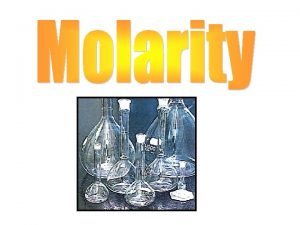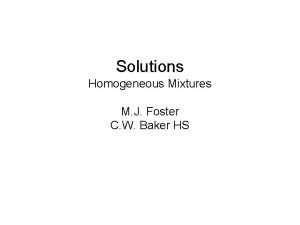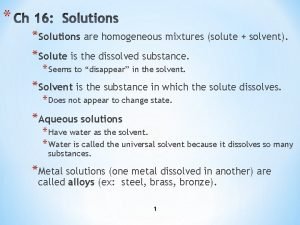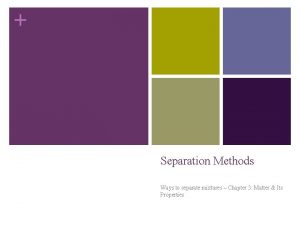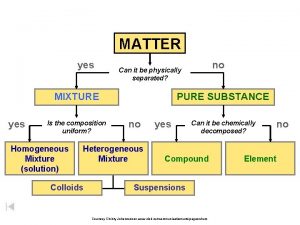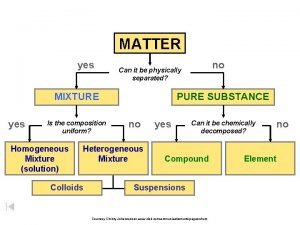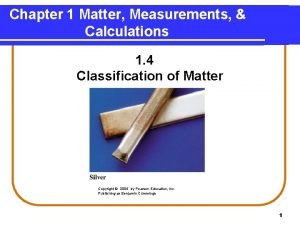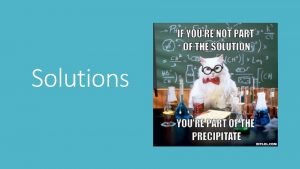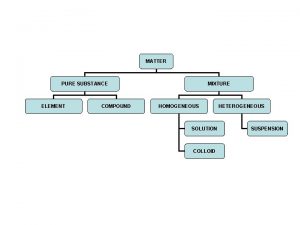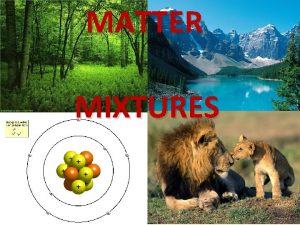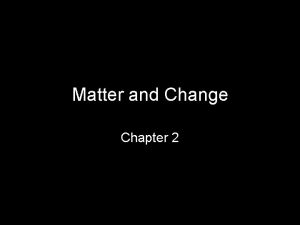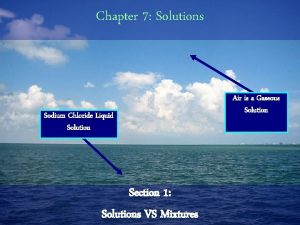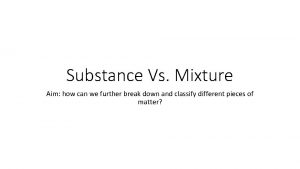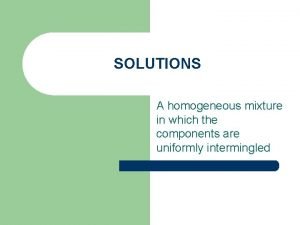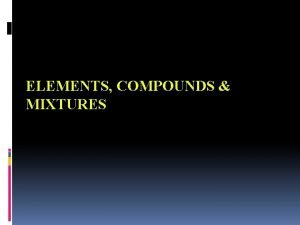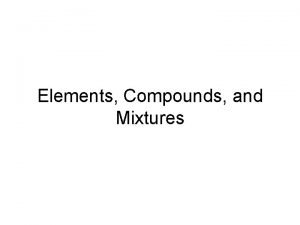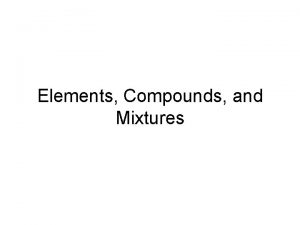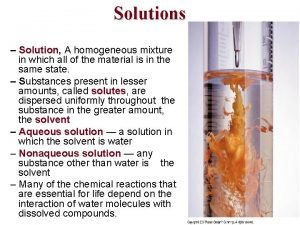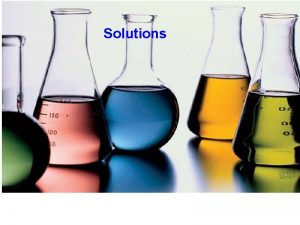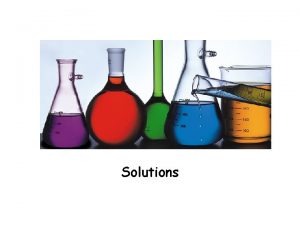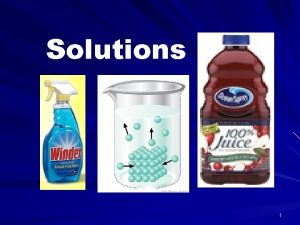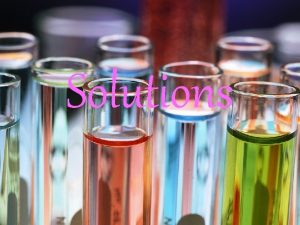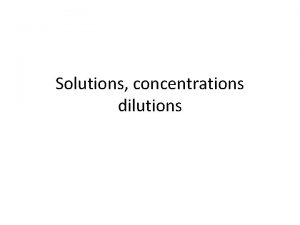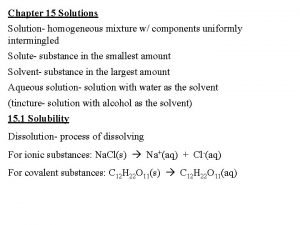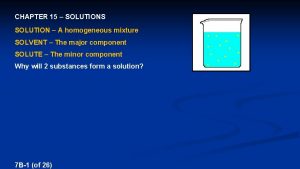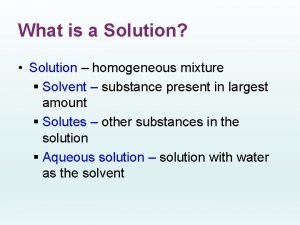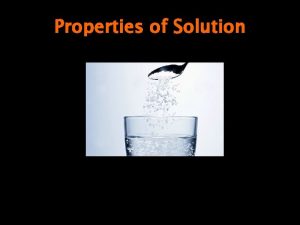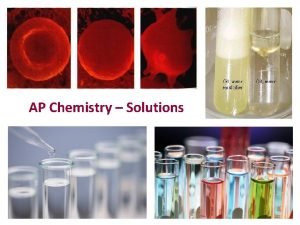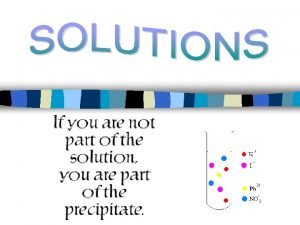Chapter 12 SOLUTIONS Solution homogeneous mixture of two































- Slides: 31

Chapter 12 SOLUTIONS!

• Solution: homogeneous mixture of two or more substances • Solute: the part being dissolved • Solvent: the part doing the dissolving • Think: YOU dissolve the sol. Ute! • Ok…now… knowing that salt water is a solution, why shouldn’t you drink it? (THINK about the concentration of SOLUTE)

Types of solutions • Aqueous solutions: water = solvent • Why is water often called ‘the universal solvent’? • Solubility = the amount of substance that will dissolve in a given amount of solvent at a given TEMPERATURE!

Why mix? • Entropy: a measure of energy randomization or energy dispersal in a system – Basically, energy wants to be evenly distributed – Think about what will happen if you hold one end of a metal rod over an open flame. Why? – Because energy wants to be evenly distributed, particles (with kinetic energy) want to be evenly distributed. THIS IS MIXING!

What about IMF? • In the absence of IMF, entropy dictates behavior = things will spread as much as possible • BUT, we know that there are ALWAYS IMF, SO…… • We look at the IMF between: • Solute and solvent • Solvent and itself • Solute and itself

• What will happen if the solvent-solvent interaction or the solute-solute interaction is much greater than the solute-solvent interaction? • WHY? • This is WHY ‘like dissolves like’

Energetics of solution formation • The process of forming a solution can be endothermic or exothermic. WHY? • Solvation occurs in three parts, you must consider the energy flow in each of the three parts to get the net energy flow

• 1. separating solute into its particles= always endothermic. WHY? • 2. Separating solvent particles from each other= always endothermic. WHY? • 3. Mixing solute with the solvent = exothermic. WHY? • You can calculate the change in enthalpy!

Hess’s Law • Enthalpy = measure of energy of a system • Change in enthalpy of solution = change of enthalpy of solute + change of enthalpy of solvent + change of enthalpy of mix

• • Describe the reaction in terms of energy flow if: Change in enthalpy of solution = about 0 Change in enthalpy of solution is negative Change in enthalpy of solution is positive • Why would a solution form at all if the change in enthalpy was negative? • ENTROPY!

Homework • Pg 561, 1 -9 • Pg 562, 29 -36 (for 35 and 36, only a + b)

Factors affecting solubility • Temperature and pressure. • Usually solubility goes up as temperature increase, not true with most gases. • Henry’s law: • Solubility (S) • Pressure (P) • S 1/P 1 = S 2/P 2 • Is this a direct or inverse relationship? ?

Molarity! • Concentration: a measure of the amount of solute dissolved in a solution – Dilute: low concentration of solute – Concentrated: high concentration of solute – MOLARITY (M)= number of moles of solute /liters of solution

• A saline solution contains 0. 90 g Na. Cl in exactly 100 ml of solution. What is the molarity of the solution? • What do you know? • 0. 90 g Na. Cl • 100 ml solution • Molarity = moles of solute / liters solution • YOU MUST CONVERT!

• How many moles of solute are present in 1. 5 L of a 0. 24 M Na 2 SO 4? • What do you know? • 1. 5 L of solvent • Molarity = 0. 24 M • Molarity = moles of solute/Liters of solvent

You can make DILUTIONS! • Sometimes you need to dilute a solution to use it. (ex. ACID in the lab) • M 1 x V 1 = M 2 x V 2 • volume must be in liters! (because molarity is moles/liter)

• How many milliliters of stock solution of 2. 00 M Mg. SO 4 would you need to prepare 100. 00 ml of 0. 400 M Mg. SO 4 M 1 x V 1 = M 2 x V 2 M 1 = 2. 00 M V 1 = ? M 2= 0. 400 M V 2 = 100. 00 m. L (CONVERT)

Percent Solutions! • If both the solvent and solute are liquids, it’s easier to make a solution by using volume. You would express concentration as a percent volume • Percent volume (%v/v) = volume of solute/volume of solvent x 100% • Percent (mass/volume)(%(m/v)= mass solute (g)/ solution volume (m. L) x 100

Let’s try it • What is the percent by volume of ethanol in the final solution when 85 m. L of ethanol is diluted to a volume of 250 m. L with water? • How many grams of glucose would you need to prepare 2, 000 ml of 2. 8% glucose (m/v) solution

Molality • Molarity depends on volume, but is volume constant? ? ? • What happens to volume with temperature changes? • We need something that is temperature independent!

• Molality (m): amount of solute(mol)/ mass of solvent (kg) NOTE: molality is defined in terms of kg of SOLVENT, not SOLUTION!!!! Molality is very useful when one must compare concentrations over a range of temperatures

• If molality is so great, why do we learn about molarity at all? ? ?

Parts by mass and parts by volume • We touched on something like this with percentages, but you will often see concentration as a ratio of masses • Percent = per hundred, so mass of solute/mass of solution x 100 = part per hundred Mass of solute/mass of solution x 106= parts per million (ppm) Mass of solute/mass of solution x 109 = parts per billion (ppb)

• You can also represent concentrations in ratios of volumes (just do it the same way, but use volume instead of mass) • Representing concentrations in this way is particularly useful in biology applications

Let’s try it • What volume (in m. L) of a soft drink that is 10. 5% sucrose (C 12 H 22 O 11) by mass contains 78. 5 g of sucrose? (the density of the solution is 1. 04 g/m. L) • Start with what you know: 78. 5 g sucrose • You want to know m. L • CONVERT!

Mole Fraction and Mole Percent • Mole fraction (Xsolute) = mol of solute/mole of solute + mol of solvent Mole % (mol %) = Xsolute x 100%

Let’s TRY it! • A solution is prepared by dissolving 17. 2 g of ethylene glycol (C 2 H 6 O 2) in 0. 500 kg of water. The final volume of the solution is 515 m. L. Find the following A) molarity= amount of solute(mol)/L of solution B) molality= mol of solute/ kg of solvent C) percent by mass= mass solute/mass solution x 100 D) mole fraction = mole solute/ mol solute + mol solvent E) mole percent= mole fraction x 100

Homework • Pg 537 practice + more practice 12. 3 • Pg 540 practice 12. 4 • Pg 563 # 51 -54

Boiling Point Elevation and Freezing Point Depression • Boiling Point Elevation: Is the boiling point of the solution minus the boiling point of the pure solvent • Boiling point elevation is proportionate to molal concentration, so we add a proportionality constant (Kb) to make an equality • Change in boiling point = Kb x m

• Same thing for freezing point depression, we just use a molal freezing-point depression constant (Kf) • Change in freezing point = Kf x m

Let’s try it! • A solution of 7. 50 g of a nonvolatile compound in 22. 60 g of water boils at 100. 78 degrees Celcius at 760 mm. Hg. Wht is the molar mass of the solute? Boiling point constant for water = 0. 512 degrees/molal
 Homogeneous mixture and heterogeneous mixture class 9
Homogeneous mixture and heterogeneous mixture class 9 A solution is a homogeneous mixture
A solution is a homogeneous mixture Polar mixture
Polar mixture Homogeneous mixture
Homogeneous mixture Non homogeneous differential equation
Non homogeneous differential equation Homogeneous mixture of a solute in a solvent
Homogeneous mixture of a solute in a solvent How can mixtures be separated
How can mixtures be separated Does copper have a uniform composition
Does copper have a uniform composition Is the composition uniform?
Is the composition uniform? Liquid homogeneous mixture
Liquid homogeneous mixture Different types of mixtures
Different types of mixtures Non examples of homogeneous mixture
Non examples of homogeneous mixture Blood is homogeneous
Blood is homogeneous Homogeneous mixture vinegar
Homogeneous mixture vinegar Elements compounds and mixtures 1 worksheet answers
Elements compounds and mixtures 1 worksheet answers Homogeneous mixture
Homogeneous mixture What is homogeneous mixture
What is homogeneous mixture Homogeneous mixture
Homogeneous mixture Pure or mixture
Pure or mixture Classification of matter class 9
Classification of matter class 9 Homogeneous mixture
Homogeneous mixture Homogeneous mixture
Homogeneous mixture Mixture particle diagram
Mixture particle diagram Is wine a homogeneous mixture
Is wine a homogeneous mixture Homogeneous mixture
Homogeneous mixture Solutions and mixtures
Solutions and mixtures Is sterling silver a pure substance
Is sterling silver a pure substance Rice pudding homogeneous or heterogeneous
Rice pudding homogeneous or heterogeneous Homogeneous mixture
Homogeneous mixture Homogeneous mixtures examples
Homogeneous mixtures examples Heterogeneous mixture
Heterogeneous mixture Is maple syrup a homogeneous mixture
Is maple syrup a homogeneous mixture

